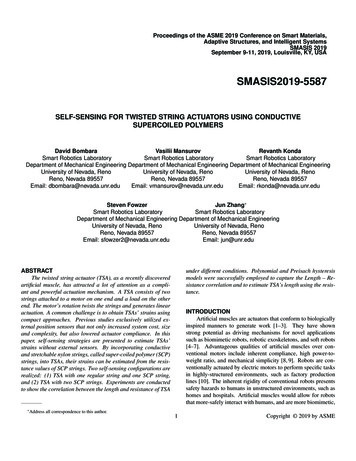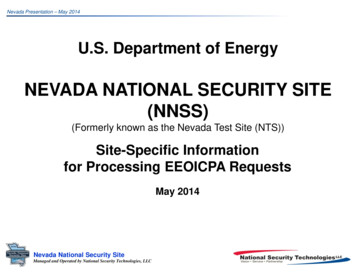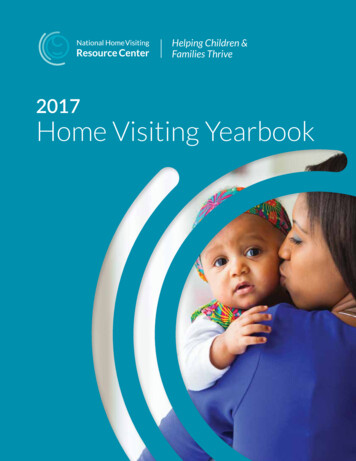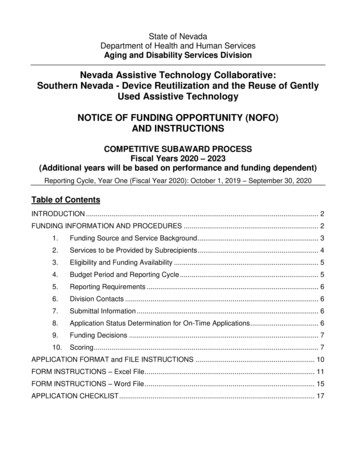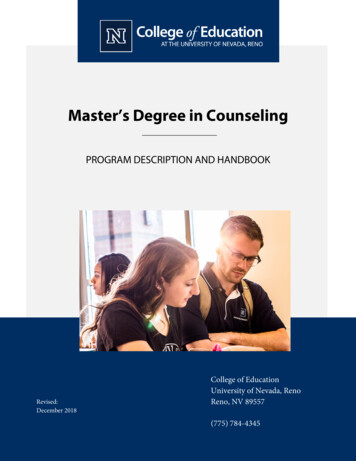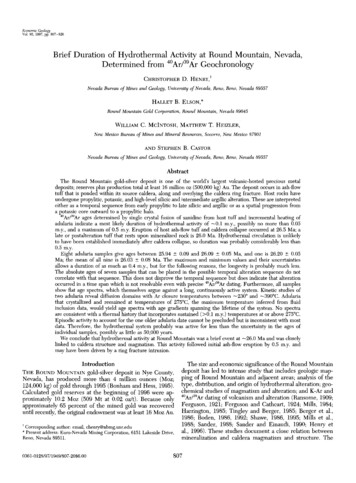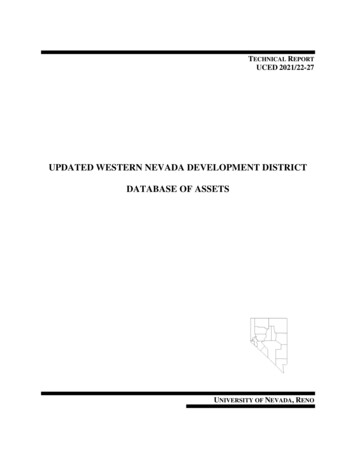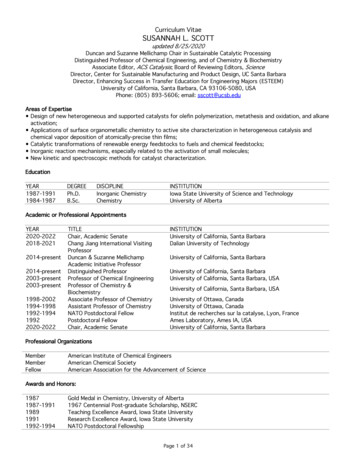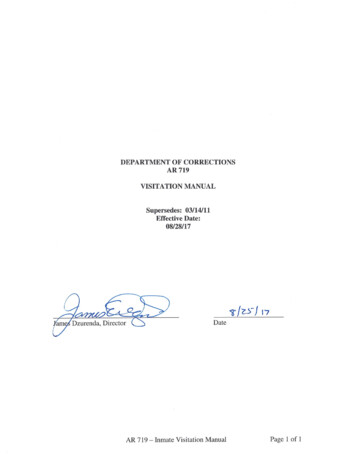
Transcription
The purpose of the Visiting Manual is to ensure written policy, procedures, and practicethat provide written information regarding visitation, including approval process, lengthof visits, and reasons to justify limitations or actions. All visits are a privilege, not aright. This manual is in compliance with the Standards for Adult CorrectionalInstitutions, 4th Edition, Section D, Mail, Telephone, and Visiting, 4-4498.1. MAINTENANCE OF VISITATION FILES/APPROVAL PROCESSA. An inmate requesting to receive a visit must first submit an Inmate’s Applicationfor Visiting Privileges (DOC-3007). This is required for each individual the inmate isrequesting to include on their respective authorized visitor list, (Maximum 5). Theexception to the maximum of five (5) is if there are copies of certified birthcertificates demonstrating that the inmate has more than five (5) biological children.The visiting room officer will then complete the top portion of the Inmate VisitingApplication form(s) (DOC-3000), initial, date, and mail the form to the prospectivevisitor(s). The Inmate’s Application for Visiting Privileges (DOC-3007) will be filedby the visiting room officer, awaiting return of the Inmate Visiting Application(DOC-3000).Any individual requesting to visit an inmate can print out a copy of the NevadaDepartment of Corrections (NDOC) Visiting Application Form (DOC 3000) locatedon the department’s website at http://doc.nv.gov. The form must be completed beforesubmitting via mail with attention, “Visiting.” If the prospective visitor does not havethe resources to print the form, they are encouraged to visit their local public libraryfor access to computers, internet and printers. Visiting application forms can also beobtained in person at any NDOC institution during normal business hours (Mondaythrough Friday, 8:00 a.m. until 5:00 p.m. If the inmate has not requested theindividual on their visitor log, the application will be denied.B. The prospective visitor must mail the completed Visiting Application Form(DOC-3000) to the institution where the inmate is currently being housed forprocessing. Applications must be completed. Any omission of information, whetherintentional or unintentional may be cause for denial of visiting privileges.C. Upon receipt of the prospective visitor’s application, an officer assigned to thevisiting room will confirm that the form is complete and that the inmate has submitteda request (DOC-3007) for the prospective visitor. The application will then be loggedinto the SCOPE book and the visitor information will be entered into the NevadaOffender Tracking Information System (NOTIS).D. If the Institution the inmate is housed does not run their own background checks,the Inmate Visiting Application(s) will be grouped into a maximum number of five(5) applications and sent along with a National Crime Information Center (NCIC)Operator Application Form (DOC-2017) to:AR 719 – Inmate Visitation ManualPage 2 of 22
Nevada Department of CorrectionsAttn: NCICP. O. Box 7011Carson City, NV 89702E. When the SCOPE is returned from the NCIC, it will be evaluated by theWarden/Designee appointed to the desired visiting institution, in accordance with theguidelines set forth in this manual and noted as approved or disapproved with asignature.(1) After the visitor is approved or disapproved, the inmate will be sent aresponse stating the visitor(s) name and disposition of the request. NOTISwill be updated by the visiting officer to reflect the disposition.(2) Approved: A letter of approval will be sent to the prospective visitor’saddress, along with a copy of the NDOC Visiting Rules and Regulations. Inaddition, the prospective visitor will be referred to the NDOC website athttp://doc.nv.gov for information regarding the visiting schedule of theapproved institution.(3) Denied: An NDOC visiting Officer will send a letter of denial to theprospective visiting applicant’s address, stating the reason(s) as to why thevisiting request was denied.(4) If a person who has been denied for visitation wishes to appeal the decision,the person must write a letter of appeal addressed to the Warden of thefacility where the inmate is being housed and attach any document(s)necessary for reconsideration.(5) If the Warden denies an appeal, the appeal will be packaged, scanned andemailed to the Deputy Director of Operations for review, comment andrecommendation. The original package will remain at the originating facility.The electronic package will contain:(a) Visiting Application;(b) NCIC / SCOPE;(c) All Related Documentation including justification for original denial;and(d) Cover Letter(6) Whether or not an approval is granted, all letters, forms and informationgathered will be placed in the inmate’s visiting file and notated in the NOTIS.(7) All non-immediate family members must re-apply for visiting privilegesevery three (3) years and submit to a background check.AR 719 – Inmate Visitation ManualPage 3 of 22
(8) Visitors must declare all inmates in which they wish to visit.F. Visiting Files/Cards:(1) Visiting Room Staff will conduct a random monthly review of all visitingfiles and update them using information from the NOTIS system. The randomreview should be documented on a monthly log.(2) Visiting Room Staff will conduct quarterly audits and submit the results to theAssociate Warden of Operations.(3) Visitors who are approved or denied for visiting privileges are logged intoNOTIS as-well as on the inmate’s Visiting Card displaying the visitor’s name,address, social security number, birth date, date approved or denied, institution,relationship to the inmate and the visiting officer’s name. Information logged intoNOTIS and displayed on the Visiting Cards will be updated regularly.(4) Visitors who have been previously approved for visiting do not need to reapply to visit a parole violator, if it has been less than two (2) years since they lastcompleted an application. If upon the arrival of the inmate, his/her originalvisiting record(s) were not received, the visiting room officer must contact theCorrectional Caseworker Specialist III (CCSIII) assigned to the institution in anattempt to retrieve the original records. To expedite the process, the inmate cansubmit a new Inmate’s Application for Visiting Privileges (DOC-3007).(5) All of these documents will subsequently be transferred as a part of theinmate’s institutional file, whenever the inmate is transferred to a differentinstitution/facility.(6) All records relating to inmate visits will be maintained in accordance with theState Records Retention Schedule.2. VISITOR ELIGIBILITYA. Prior Approval:(1) Visitors wishing to visit an inmate should contact the visiting room officer atthe facility where the inmate is assigned twenty-four (24) hours in advance, toreceive information concerning any possible changes in the inmate’s visitingstatus.(2) The maximum number of visitors an inmate may receive and the length ofeach visit may be limited due to the facility’s schedule and NDOC’s first priorityfor the safety and security of the institution or when there are substantial reasonsto justify such limitations.AR 719 – Inmate Visitation ManualPage 4 of 22
(3) Any person wishing to visit an inmate must have prior approval and must belisted on the inmate’s approved visitor list. Any person arriving at the institutionwithout prior approval will not be permitted to a visit unless the Warden or anAssociate Warden grants an exception.(4) Inmates who have current or prior convictions, or were arrested for a sexualcrime involving a minor, or other violence/abuse of a minor are ineligible to visitwith the victim of their crime while the individual is still a minor, unless soordered by the court. They shall also be ineligible to visit with any other minorwithout specific approval from the Deputy Director. This responsibility shall notbe delegated. The inmate, as well as the custodial parent/legal guardian of theminor shall read and sign the Agreement for Contact Visitation with Minors(DOC-3020). This form and the Application for Visiting Privileges with Minors(DOC-3006) is available through the visiting room staff.B. Identity of Visitor:(1) Visitors must present proof of identification, i.e., State or federally issuedI.D., Driver’s License, Passport, or Consular I.D. and other vital informationneeded upon request of institution officials before being permitted to receive avisit. Visitors without verifiable picture identification will not be permittedto access the Institution and may not receive a visit with an inmate.(2) Identification of minors less than 16 years of age may be established with acertified copy of their birth certificate, which will be kept in the Visiting File.(3) Non-biological children of the inmate will be allowed to visit under thefollowing criteria:(a) The person bringing the non-biological child/children for visitation mustprovide appropriate documentation such as a birth certificate or courtdocument establishing their relationship with the child/children prior to thevisit.(b) Unless there is a court order, visits will not be approved regardless of thechild’s relationship, if the child/children are a victim of the inmate.(c) A notarized statement is required from the parent of the child/children or a“legal guardian” if the child/children are visiting without their parent.(d) A non-family member of the child cannot bring the child/children to visitthe inmate. However, an immediate family member may bring thechild/children to visit if:1. A notarized statement approving such a visit is received from thecustodial parent/legal guardian.AR 719 – Inmate Visitation ManualPage 5 of 22
2. The immediate family member is an approved visitor of the inmate.C. Visits by Relatives:(1) Immediate family is defined as a husband, wife, father, mother, step-father,step-mother, sons, daughters, brothers, sisters, grandparents, grandchildren, stepchildren and/or legal guardian (such as foster parent), aunts and uncles.(2) Immediate family members under the age of 16 must be accompanied by anadult who is an immediate family member of the child.(a) If the adult is not a parent, they must provide a written notarized letterfrom the custodial parent or legal guardian.1. The letter must contain the following information: name of adult andname of child/children.2. A certified copy of the birth certificate is required for identification ofall minors under 16 years of age.(b) Minors between the ages of 16 and 18 will be allowed to visit without anapproved adult if they present a notarized authorization from their custodialparent or legal guardian.(c) Visitors between the ages of 16 and 18 must present a government issuedphoto I.D. A birth certificate will not be accepted.D. Visits by Friends:(1) Friends of an inmate may visit, but must abide by the criteria set forth insections 1 and 2 above. The Warden or Associate Warden must approve anyexceptions.E. Visits by Former Inmates or Persons on Parole or Probation:(1) No person who has been convicted of a felony in any state will be allowedto visit unless prior written approval is received from the Deputy Director.This responsibility cannot be delegated.(a) The request will be submitted to the Warden for initial consideration andthen to the appropriate Deputy Director for review based upon therecommendation of the Warden.(b) Ex-felons, other than immediate family members, who are approved forvisiting, should be individuals who are representatives of approvedAR 719 – Inmate Visitation ManualPage 6 of 22
organizations or agencies arranging employment or other valuable assistanceto the inmate.(c) Persons on probation or parole must obtain written consent from their casesupervisor before the visits will be considered. Persons with charges pendingagainst them will be denied visiting privileges, unless the Warden or DeputyDirector approves their visitation request.F. Visits Between Current and Former Employees and Current Inmates:(1) Current and former employees of the NDOC may request visiting privilegeswith an inmate on an individual basis. The request will be submitted to theWarden for initial consideration and recommendation, and to the Deputy Directorfor final approval.G. Persons Visiting More than One (1) Inmate:(1) No person may be given permission to visit more than one (1) inmate of theNDOC except:(a) Attorneys; or(b) Clergy; or(c) Immediate family members; or(d) In the event that two (2) or more immediate family members are inmatesin the NDOC and a visitor received approval to visit them, this visitor will notbe given approval to visit any other non-family inmate.(2) Immediate inmate family members that are housed at the same institution andin the same custody level will be authorized for visits with approved immediatefamily members at the same time and location.(3) Approval for a person to change from one visiting list to another will only beconsidered after the applicant has terminated, in writing, visiting with the originalparty for a period of at least six months, unless there are extenuatingcircumstances involved.(a) The request will be submitted to the Warden for consideration.(b) If removed from a visiting list by the visitor or inmate’s request, thevisitor may not re-apply for a period of at least six months.H. Health Restrictions:AR 719 – Inmate Visitation ManualPage 7 of 22
(1) Any person presenting any potential health problems to inmates or staff willnot be allowed to receive visitation privileges. The institution’s medicaldepartment will make this determination upon notification by the visiting roomstaff.(2) Inmates housed in the infirmary will receive visits in accordance with AR619, Institutional Infirmary Care.I. Inter-Institutional Visits:Inmates may be considered to visit immediate family members in another institutionif the relationship can be verified.(1) Only immediate family members will be considered and approval must bereceived from both institutional Wardens.(2) This will be considered in emergency situations such as a death within theinmate’s immediate family.J. Outside Groups and News Media:Visits from outside groups, or the media will be conducted in accordance withAdministrative Regulation 120, concerning News, Media Contacts and PressReleases.K. Members of the Clergy:(1) Members of the clergy, as recognized by the chaplain, Warden or AssociateWarden need not be placed on the approved visitor list. However, properidentification is required and must be produced upon request.(2) Members of the clergy are subject to visiting rules and regulations.L. Attorneys: Attorney visits will be conducted in accordance with AdministrativeRegulation 722, Inmate Legal Access.M. Volunteers: this program functions as a separate entity from the normal visitationprogram and will be handled in accordance with Administrative Regulation 802,Community Volunteer Program.AR 719 – Inmate Visitation ManualPage 8 of 22
3. SPECIAL VISITSA. Special visits are an exception. The Warden or Associate Warden may approvethe following types of special visits; however, these visits must be approved no lessthan 24-hours in advance. Additionally, all special visits prior to the backgroundcheck may be subject to NON-CONTACT ONLY VISIT, as determined by theWarden:(1) Verified immediate family members may be approved for a one-time/noncontact only visit prior to the visiting application being approved.(2) Prospective employers, sponsors, parole advisors or private therapists(recognized professionals).(3) Official visitors.(4) Approved visitors arriving at the facility to visit on a day other than regularscheduled visiting days.B. If absolutely necessary, special visits may be approved for hours other than thenormal scheduled visiting hours, or for longer durations than a regular visitingschedule would allow.C. All other circumstances for Special Visits are at the discretion of the Warden.4. HOLIDAY VISITINGA. The Warden may choose to open the Visiting Room on holidays that may fall ondays in which visiting is normally closed (e.g. Thanksgiving and Christmas). Thesespecial arrangements will be determined in advance and posted accordingly so thatvisitors can make arrangements.B. Holidays bring an increased number of visitors. It is at the discretion of theGatehouse and Visiting Officers to adjust the length of time for visits in order toaccommodate all those scheduled.(1) Certain allowances for the length of a visit may be approved for visitors whohave traveled from a great distance.(2) All visits should be scheduled with the Institution’s Visiting Room Officer toavoid overcrowding.5. HIGH RISK POTENTIAL (HRP) INMATESA. High Risk Potential (HRP) inmates will visit behind glass only, unlessspecifically approved for a contact visit by the Warden. (In cases of contact visits forAR 719 – Inmate Visitation ManualPage 9 of 22
HRP inmates, Correctional Emergency Response Team (CERT) staff will bepresent during the visit. HRP inmates are to remain in waist and leg restraintsduring the visit). For Attorney visits with an HRP inmate, CERT staff will remainoutside of the visiting room and staff will maintain visual contact.6. SECURITYA. Sign(s) will be conspicuously posted at the road(s) and checkpoint entrances toeach institution/facility stating:(1) “ALL PERSONS AND VEHICLES ARE SUBJECT TO SEARCH.FIREARMS, WEAPONS, DRUGS, ALCOHOL, AND TOBACCO PRODUCTSARE PROHIBITED. VIOLATORS WILL BE PROSECUTED.”(2) “NO UNAUTHORIZED CELL PHONES OR ELECTRONIC DEVICESARE ALLOWED WITHIN THE INSTITUTION.”(3) “NO TOBACCO PRODUCTS BEYOND THIS POINT.”B. Video or other surveillance may be conducted in the Visiting Room.C. Each institution/facility shall maintain a record of the names of all visitorsadmitted to the institution to visit inmates including: sufficient identification of thevisitor, the dates and times of arrival, departure and purpose. This record shall bemaintained along with or separate from the inmate’s visitation file. This informationis logged on the Daily Visitor Sign-In Sheet (DOC-3004).D. Visitors shall not enter any area of the institution/facility except for approvedvisitation areas and approved routes to and from these areas.E. Any visitor who refuses to sign a Consent to Search form (DOC-1615) or submitto a routine search will not be allowed to visit.F. Visitors will submit to a search of their person (i.e., clothed body search andmetal detector inspection), vehicle or any other property, in which they have broughtonto NDOC property. All visitors may also be fingerprinted.G. If at any time during the process of searching or visiting, there is reasonablesuspicion that a visitor has possession of contraband, a shift supervisor will benotified.(1) Reasonable suspicion includes, but is not limited to, unauthorized touchingbetween the visitor and inmate or unauthorized actions between visitors and theother inmates in the visiting room.AR 719 – Inmate Visitation ManualPage 10 of 22
(2) The shift supervisor must be contacted and must respond to the visiting area.The shift supervisor will then assess the situation and determine the appropriatecourse of action.(3) If it is believed/determined that the visitor has violated any rules of thevisitation, the visit may then be terminated in accordance with institutional policy.(4) If it is believed that a criminal act has been committed by the visitor (ie,possession of an illegal substance) the Associate Warden/Warden will be notifiedand the appropriate local law enforcement agency will be contacted to respond.(5) The Officer, as well as the Shift Commander shall document the entireincident in NOTIS and advise the Associate Warden and/or the Warden of adecision and/or disposition concerning the status of the visitor, including, thisvisitor receiving further visits to any of NDOC’s Institutions. .H. When an inmate needs to use the restroom, a visiting officer of the same genderwill pat down the inmate entering and leaving the restroom and step inside of therestroom with the inmate throughout his/her use of the facilities at the discretion of aVisiting Officer Supervisor.(1) This will ensure the integrity of the visiting room.(2) This will be completed by the officer of the same gender.7. DENIAL, TERMINATION AND SUSPENSION OF VISITSA. The intended visit may be denied by the shift supervisor if:(1) The visitor refuses to show appropriate and bona-fide identification (Federal,State or International issued photographic identification Card).(2) The visitor refuses to submit to a routine inspection of his person, property orvehicle.(3) The visitor is under the influence of drugs or alcohol.(4) The visitor fails or refuses to control their children.(5) The visitor is not appropriately dressed.(6) There is insufficient space or security for visiting.Denials must be documented in shift logs and appropriate NOTIS entries must becompleted. Visitors may appeal to the Warden of the facility on the next business dayfollowing the denial.AR 719 – Inmate Visitation ManualPage 11 of 22
B. Prior to termination of a visit, less restrictive measures may be used (verbalwarnings to the inmate and/or visitor). The officer on duty and in charge of thevisiting room will use his/her chain of command to request termination of the visit if:(1) Visitors violate visitation conduct rules.(2) Visitors fail to control children.(3) Visitors and inmate engage in publicly unacceptable physical contact.(4) Visitors or inmate defaces furniture, walls, carpets or other fixtures.(5) The inmate violates institutional rules, regulations or procedures.C. The Warden or Associate Warden may suspend visiting privileges of a visitorindefinitely due to the seriousness of the offense and will be reviewed every six (6)months for reconsideration by the Warden at the written request of the visitor.Possible suspension offenses include:(1) The visitor and/or inmate appear to be inebriated.(2) Visitor and/or inmate repeatedly violate rules.(3) Visitor continually fails to control children.(4) Visitor and/or inmate will not, after verbal warnings, refrain from publiclyunacceptable physical contact.(5) Visitor and/or inmate possess any contraband.D. Denial and any subsequent restriction, suspension, or termination of previouslyapproved visits, shall be documented for inclusion in the inmate’s visiting file and acopy sent to the application/visitor as soon as practicable.(1) Such documentation will include the name of the official taking or orderingthe action, clearly explain the reason for the action, the length of time in whichthe action will apply, the circumstances under which the action will bereconsidered and instructions for appealing the action taken.(2) An entry in NOTIS will be made for any denial or termination of a visit. AnOIC will also be completed, when appropriate.E. The visiting center is furnished and maintained in order to make the visit aspleasant as possible. Any abuse of the facilities or intentional damage to furnishingsmay result in termination of current and future visits.AR 719 – Inmate Visitation ManualPage 12 of 22
F. Visitors must confine their visits to the area specifically set aside for visiting.Wandering about can result in the termination of the visit.8. INMATE NOTIFICATIONA. When a visitor has arrived at the institution and has been processed by thegatehouse officer or other designated visitor point of entry, the visiting room officerwill be notified of the inmate who is receiving a visit. (Pink card, file and NOTISwill be reviewed, and the file should be kept available by Visiting Room staff forreference during the visit.)B. The visiting room officer will notify the inmate of the visit only after verifyingthat the visitor has been authorized to enter the facility. This will be accomplished bynotifying:(1) The inmate’s housing unit;(2) The inmate’s work assignment; and(3) Paging the inmate on the yard.C. If the inmate has not arrived within a reasonable amount of time, the visitingroom officer will determine if the inmate was notified. If the inmate was not notified,the officer will again attempt to reach the inmate. The officer will also notify the shiftsupervisor that the inmate was not able to be located.9. INMATE PROCESSINGA. When an inmate arrives at visiting, he will receive a clothed or unclothed searchby visiting room officers per institutional discretion.B. Areas may be assigned for seating at the discretion of the Visiting Room Officer.C. Inmate dress code for visiting:(1) Inmates will bring with them their NDOC identification card which will behanded over to the Visiting Officer upon entry into the Visiting Room andreturned upon release from the Visiting Room.(2) Inmates will wear only State issued or resembling issued blue denim shirtsand pants. Shirts will be tucked in and buttoned to the second button from thetop. Clothes should be neat, unsoiled, and un-tattered.AR 719 – Inmate Visitation ManualPage 13 of 22
(3) A white crew neck T-shirt and underwear will be worn beneath the aboveapproved items at all times in the visiting area. Failure to comply will result intermination of the visit.D. The inmate will be allowed into visiting with:(1) An ID card.(2) Photo Coupons from the Canteen.(3) Wedding Ring.(4) One (1) necklace of a religious nature (as approved by AR 810).E. Inmates will not be allowed to:(1) Wear or take a jacket into the visiting room.(2) Wear or take jewelry, other than a wedding ring and one (1) necklace, whichis of a religious nature, into the visiting room.(3) Wear clothing that violates the institutional inmate dress code.(4) Bring unauthorized items to the Visiting area; i.e. watches, earrings,sunglasses, etc. (These items must be left in their units and will not be held bystaff).F. During the visit, inmate(s) will not be permitted to:(1) Wear or put on clothing and/or jewelry belonging to a visitor.(2) Accept and/or receive any item from a visitor except for items purchasedfrom the vending machines in the visiting area.10. INMATE VISITING RULESA. Failure to comply with these rules may result in the termination of the visit.B. Inmates must remain seated at their assigned tables unless authorized by thevisiting room officer to move from that position.C. Inmates may not utilize the vending machines. Inmates may have their visitorpurchase any item they desire from the vending machines.D. Authorized physical contact with visitors shall be limited to:AR 719 – Inmate Visitation ManualPage 14 of 22
(1) One (1) embrace and one (1) kiss at the beginning and end of the visitation.Placement of hands/arms during the embrace will not be below the waist areaof either person.(2) Holding hands across the top of the table (no higher than elbows).E.Unauthorized physical contact includes:(1) Petting.(2) Sitting in laps (excluding children).(3) Laying against, across or on top of one another.(4) Close body contact while standing, sitting, or lying on the ground.(5) Sharing chairs.F.Inmates will remain on opposite sides of tables from their visitors at all times.G.Occupants of the visiting area must remain appropriately clothed at all times.H.Minors will be the responsibility of the adult visitor they came in with.I.Only items in which the inmate was authorized to bring into visiting may betaken out of visiting (with the exception of photos taken by Staff).11. CONDUCT OF VISITORSThe visiting center is furnished and maintained in order to make visits as pleasant aspossible. Any deliberate or negligent abuse of these facilities may result in suspension ofcurrent and future visits.A. Visitors must wear sensible, conservative attire as outlined below.B. Visitors will not be allowed to wear clothing similar to a standard inmate issue;i.e., blue denim shirts and/or pants (jeans).C. Visitors will not be permitted to enter any Institution/facility if they do not meetdress code standards. Persons may not enter the prison grounds barefoot or wearingshorts, midriffs, halter, tank tops, or wrap-around skirts etc.D. Visitors must conduct themselves in an acceptable manner and are subject to therules at all times while on or near the premises of the institution they are visiting.E. Minors, under the age of sixteen (16) years old must be under the directsupervision of an adult visitor(s).AR 719 – Inmate Visitation ManualPage 15 of 22
CLOTHING:Visitors are expected to wear sensible, conservative attire. The following is issued as aguideline:A. No blue denim jeans, jackets, skirts, etc.B. No shorts, (exception: children under the age of eight (8) years).C. No white T-shirts.D. No see-through clothing.E. No bare midriffs blouses.F. No halter or tank tops.G. No sleeveless shirts.H. No revealing or low-cut blouses, dresses or shirts (front collar should be no lessthan 2 inches above cleavage).I. No plunging necklines either on the back or front of any garment.J. No mini-skirts or mini-dresses, as defined as less than two inches above the knee.K. No slits longer than three inches (3") in skirts/dresses.L. No wrap-around skirtsM. Spandex-type pants when worn as outer garments; i.e., stirrups, stretch, tightfitting pants will only be allowed with a shirt that extends beyond the length of thefinger-tip. (Exceptions to stretch clothing will be made for pregnant women.)N. No stretch skirts, no tight-fitting skirts of any fabric.O. No bare-feet or flip flops. Shoes must be worn at all times.P. No hats, headbands, scarves, or bandannas.Q. No clothing with any gang affiliation logos, foul language, offensive logos (toinclude but not limited to swastikas, violent images, or other, at the discretion of thedesignated staff member).R. No wigs, toupees, or hair pieces.S. No sunglasses (prescription only).T. Ladies and men must wear undergarments as appropriate to includeundergarments at all times.U. No jewelry in excessive amounts. (At the discretion of the designated staffmember)V. Visitors should refrain from wearing heavy perfumes or bo
Application form(s) (DOC-3000), initial, date, and mail the form to the prospective visitor(s). The Inmate's Application for Visiting Privileges (DOC-3007) will be filed by the visiting room officer, awaiting return of the Inmate Visiting Application (DOC-3000). Any individual requesting to visit an inmate can print out a copy of the Nevada
